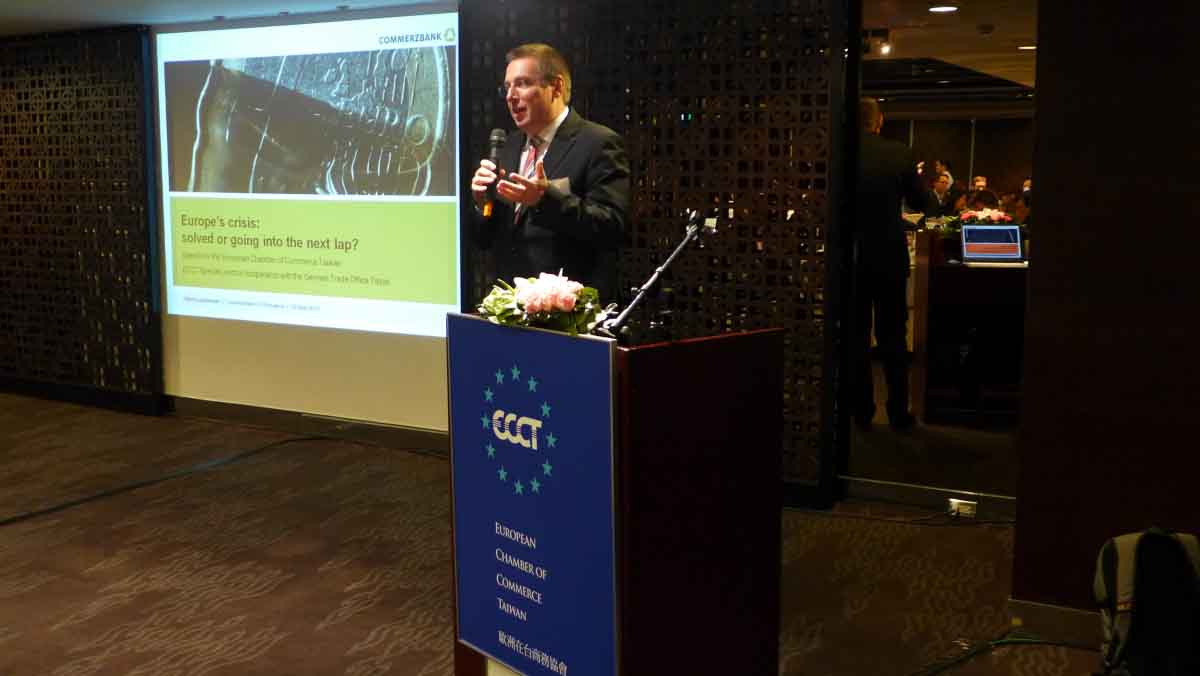Europe's crisis: Solved or going into the next lap?

Ulrich Leuchtmann began with an update on the Eurozone economy. After several years in crisis mode, there have been some positive signs from Europe recently.
Volatility in foreign exchange rates, particularly between the US dollar and the euro has declined to its lowest level since the global financial crisis in January 2008, which indicates that the crisis period in financial markets is over and things have returned more or less to normal. The European Central Bank's (ECB) promise of "unlimited" bond market interventions (OMT) in the summer of 2012 was the game changer that assured investors. Unlike previous attempts to shore up confidence by EU governments pledging fixed amounts to various rescue funds, the promise of unlimited OMT eased fears that there would not be enough ammunition to deal with any given crisis.
This resulted in the risk premiums for government bonds of southern European countries falling sharply, so much so that, absent the Eurozone tail risk and because these bonds offer higher yields than countries such as Germany, they have now become attractive investment targets for large investors such as pension funds.
While there was capital flight during the crisis, this was reversed following the OMT promise, and now there seems little demand for liquidity. The ECB has become more restricted, not on purpose but as a consequence of abatement of the crisis. With interest rates having been cut to close to zero by the ECB and the US Federal Reserve, there is no more room to cut rates in the US and Europe. In terms of monetary expansion, the Fed has been the most expansionary to date, now in its third round of quantitative easing. This is likely to cause the euro to appreciate. Leuchtmann's believes that euro appreciation is not as much of an issue for countries like Germany, which focuses on producing high value-added items that are not so price sensitive.
It is more of a problem for producers of lower value price-sensitive products.
The Bank of Japan recently began expanding aggressively but the ECB has actually reduced money supply in recent months. The ECB's large bond buying programmes in 2010 and 2011 have not had any lasting impact to date. This will last as long as confidence remains strong and the ECB is not tested on its OMT promise and forced to intervene in markets to buy bonds.
While the OMT promise was a clever move according to Leuchtmann, there is a risk, now that things have stabilized, that Eurozone governments will abandon austerity and go back to spending beyond their means.
While stimulus measures may boost GDP in the short term, there is a risk that money will be wasted on projects that provide no long-term benefits, while saddling the governments with more long-term debt.
Things are looking stable now but could become very rocky if there is an erosion of confidence and the ECB's OMT promise is really tested.
In Leuchtmann's view, the long-term solution to a stable financial environment is to have binding rules for Eurozone governments on fiscal responsibility.
In his presentation, Charlie Lay said that the global economy is on the mend led by recovery in US housing. Global asset prices have risen on the back of continued Quantitative Easing (QE) policies around the globe, from the Fed' to Bank of Japan recently. The tail risks of the US debt ceiling, a hard landing in China and a break-up of the Eurozone are receding. However, the real test for equities will come when the recovery takes off in earnest and the Fed' stops printing money and raises interest rates, something which has to happen eventually. Companies with good cash flow will do well when this happens.
Lay also believes that South East Asia remains a positive domestic-consumption-driven story. Commerzbank forecasts 2% GDP growth for the US but a continued recession in the EU. The bank believes the US labour market is recovering with the hires-to-vacancies rate back to pre-recession levels. According to the bank's analysis, there have been huge sectoral shifts in the US labour market with a reversal from job losses to gains in mining & logging, manufacturing, trade, transportation, utilities, professional services, leisure and hospitality while gains in education and healthcare services (which never fell during the recession) continued to increase.
In Asia, a major problem is too much liquidity looking for yield in a low interest global environment. This has resulted in bubbles in several regions and sectors, especially property. Lay believes Asian economies are much more resilient than they were 16 years ago, the
1997 Asian financial crisis. Since then there has been a considerable degree of deleveraging, leaving Asian economies much stronger. Major Asian economies should prepare for much slower growth rates as they transition from developing to developed economies.
Lay expressed cautious optimism about Taiwan's prospects as a high tech manufacturer given better book-to-bill figures for the semiconductor industry (a leading indicator of better sales ahead) and Taiwan's exposure to the mobile device supply chain, which continues to grow strongly.
